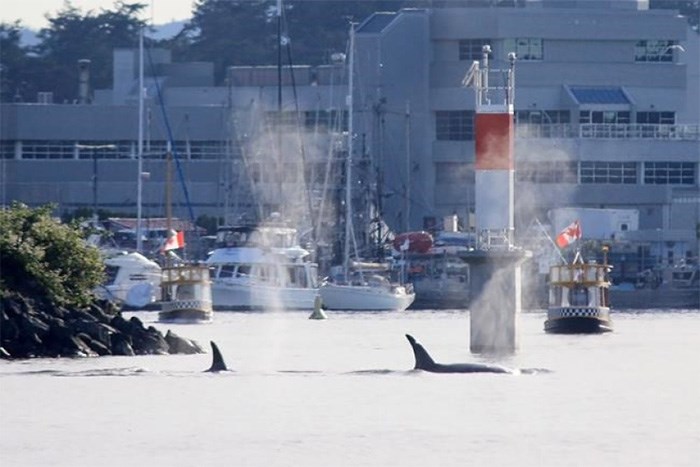 A pod of orcas is shown in Victoria on Sunday, June 17, 2018 in this handout photo. A pod of orcas has made a brief visit to Victoria Harbour, the second visit by a group of killer whales in 10 days. Jackie Cowan, who lives on a boat in the harbour and is also a captain with a Victoria whale watching company says the pod cruised in on Sunday evening. THE CANADIAN PRESS/HO – Jackie Cowan
A pod of orcas is shown in Victoria on Sunday, June 17, 2018 in this handout photo. A pod of orcas has made a brief visit to Victoria Harbour, the second visit by a group of killer whales in 10 days. Jackie Cowan, who lives on a boat in the harbour and is also a captain with a Victoria whale watching company says the pod cruised in on Sunday evening. THE CANADIAN PRESS/HO – Jackie Cowan
A pod of orcas has made a brief visit to Victoria Harbour, the second excursion by a group of killer whales in as many weeks.
Jackie Cowan, who lives on a boat in the harbour and is also a captain on a whale-watching vessel, says the pod cruised in on Sunday evening.
She identified them as transient orcas, which prey mainly on seals, sealions and dolphins.
Cowan says the group of at least four orcas arrived in the harbour as they tracked the tide line and the marine creatures it carried with it following a very low ebb tide earlier in the day.
The pod left the harbour about 30 minutes later.
On June 4, another pod of transient orcas spent about an hour in the harbour, marking the first appearance of the mammals in the waterway in decades.
Cowan says Sunday's visit was likely related to the recent low tides.
"Animals and organisms that aren't normally affected by tide were swept out with exceptionally low tides of recent days and were coming back in with (the rising) tide," Cowan said.
She said smaller marine mammals that are the whale's usual prey would likely have been following the large amount of nutrients carried along by the tide, which is why the killer whales were not far behind.
![]()


